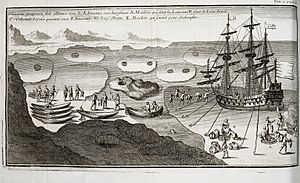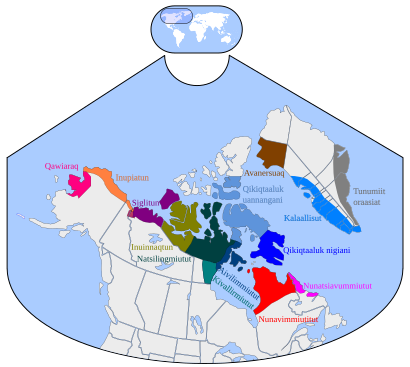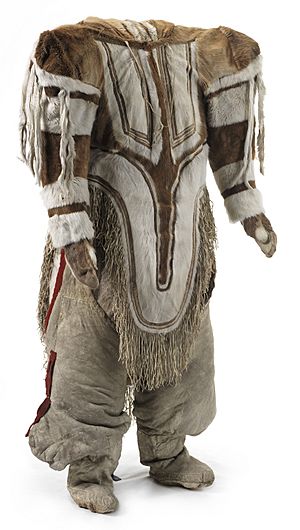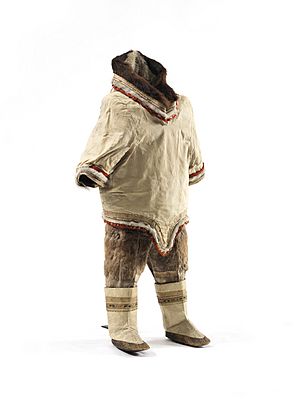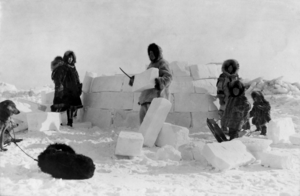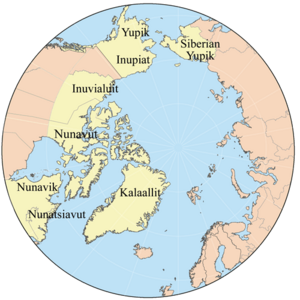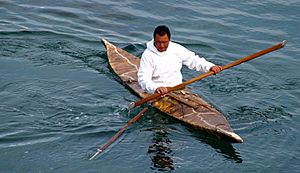Inuit facts for kids
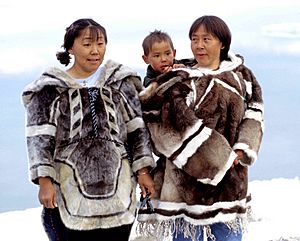
Igloolik Inuit women and child in traditional parkas (1999)
|
|
| Total population | |
|---|---|
| 154,378 | |
| Regions with significant populations | |
| Canada | 70,540 (2021) |
| Greenland | 50,787 (2017) |
| Denmark | 16,470 (2018) |
United States
|
16,581 (2010) |
| Languages | |
|
|
| Religion | |
| Christianity, Inuit religion | |
| Related ethnic groups | |
| Aleut, Yupik, Indigenous people of the Americas | |
The Inuit are a group of indigenous peoples who live in the cold Arctic and subarctic areas. These regions include Greenland, Labrador, Quebec, Nunavut, the Northwest Territories, and Alaska. For many years, Europeans called them Eskimo, but the Inuit find this word offensive. The word Inuit means "the people" or "the real people" in their language.
The Inuit languages are part of a larger group called Eskimo–Aleut languages. This language family is also known as Inuit-Yupik-Unangan or Eskaleut.
Contents
What is the history of the Inuit people?
Early history of the Inuit
The Inuit are descendants of the Thule people. The Thule people first appeared in western Alaska around the year A.D. 1000. In Canada and Greenland, most Inuit lived north of the "arctic tree line". The most southern Inuit community officially recognized today is Rigolet in Nunatsiavut, Canada. It is located in northern Newfoundland and Labrador.
Around A.D. 1350, the weather became much colder during a time called the Little Ice Age. This cold period did not affect the Alaskan Inuit much, and they continued their whaling. However, Inuit living in the high Arctic had to move south. They also had to change their way of life, which had depended on materials from whales.
The first Europeans the Inuit met were the Vikings. The Vikings had settled in Greenland centuries before. Viking stories, called sagas, mention meeting the Inuit, whom they called Skræling.
How did Europeans affect the Inuit?
First meetings with Europeans
In 1576, Martin Frobisher was looking for the Northwest Passage. During his journey, he met the Inuit. Inuit oral tradition says that five of Frobisher's crew members lived with them for a few years. They later died trying to leave Baffin Island in a boat they built themselves. Frobisher, while searching for his men, captured three Inuit. He took them back to England, and they were likely the first Inuit to visit Europe.
The Inuit were semi-nomadic, meaning they moved with the seasons. They were skilled fishermen and hunters, getting food from lakes, seas, ice, and the tundra. Some historical accounts say the Inuit were unfriendly towards early French and English explorers, fishermen, and whalers. However, other stories suggest they traded peacefully with them. The Europeans brought new diseases, which caused many Inuit to become sick and die.

Changes in the 20th century
As Canada's population grew, the Canadian government and businesses began to expand north. They were especially interested in areas rich in fur and minerals. By the late 1920s, all Inuit had met traders, missionaries, or government officials. In 1939, Canada's highest court decided that Inuit should be treated like other Indigenous peoples. This meant they were under the federal government's care.
The Royal Canadian Mounted Police (RCMP) began to enforce Canadian criminal law on the Inuit. The Inuit often did not understand these new Canadian rules.
In the 1950s, the Government of Canada started what was called the High Arctic relocation. Inuit families were moved to the far northern Arctic. They were promised they could continue their traditional way of life. However, they were left without enough supplies but eventually learned how to survive. The Canadian government also began to settle Inuit into permanent villages and cities, sometimes against their will. Inuit children started attending local public schools. Many Inuit felt that Canadian education taught values that did not fit their traditional culture.
By the 1960s and 1970s, Inuit became more involved in politics. They fought for their land rights. Finally, in 1999, the new territory of Nunavut was created. Most of the people living there are Inuit.
What is Inuit culture like?
Inuit languages
Inuit speak several languages, including Inuinnaqtun, Inuktitut, Inuvialuktun, and Greenlandic languages. These languages are part of the Inuit-Inupiaq branch of the Inuit-Yupik-Unangan language family. Greenlandic languages are divided into Kalaallisut (Western), Inuktun (Northern), and Tunumiit (Eastern).
Inuit in Alaska and Northern Canada often speak English. In Greenland, Inuit also speak Danish and learn English in school. Canadian Inuit may also speak Québécois French.
What do Inuit people eat?
The Inuit have traditionally been fishermen and hunters. They still hunt whales (especially bowhead whale), seals (like ringed seal and harp seal), polar bears, muskoxen, birds, and fish. Inuit diets are mostly made of healthy fats (about 75%) and protein.
It is hard to grow plants for food in the Arctic. However, the Inuit have traditionally gathered plants that grow naturally. Grasses, tubers, roots, plant stems, berries, and seaweed (called kuanniq) were collected. They were preserved depending on the season and where they were found.
What are Inuit tattoos?
The ancient art of face tattooing among Inuit women is called kakiniit or tunniit in Inuktitut. This tradition dates back nearly 4,000 years. The traditional way of tattooing was done with needles made of sinew or bone. These needles were soaked in animal fat and sewn into the skin. Today, modern ink and needles are used.
How do Inuit travel?

The Inuit hunted sea animals from single-passenger boats called qajaq, or kayaks. These boats were covered with seal skin. Inuit also made umiaq ("woman's boat"). These were larger open boats with wood frames covered in animal skins. They were used to transport people, goods, and dogs.
Dogs were very important to Inuit life. In winter, on land and sea ice, the Inuit used dog sleds (qamutik) for travel. Dogs also protected Inuit villages by barking at bears and strangers. The Canadian Eskimo Dog, the Greenland Dog, the Siberian Husky, and the Alaskan Malamute are common dogs in the Arctic. Today, Inuit also use snowmobiles for travel.
What are Inuit art and clothing like?
The Inuit used materials found in their environment for their daily needs. Animal hides, driftwood, bones, and stones were used to make tools and weapons. They even found and used the Cape York Meteorite as a source of iron.
Art has always been a big part of Inuit society and still is today. Small sculptures of animals and human figures were carved from ivory and bone. These often showed everyday activities like hunting and whaling. In modern times, Inuit use soft stone to make prints and carved figures.
Inuit wear thick, warm clothing and footwear to survive the cold weather. Traditional Inuit clothing and footwear are made from animal skins and furs. They are sewn together using needles made from animal bones and threads made from animal products like sinew. A warm coat is called an anorak, and boots are called mukluk or kamik.
Inuit people often lived in temporary shelters made from snow called an igloo. When temperatures were above freezing, they lived in tents, known as tupiq. These tents were made of animal skins supported by a frame of bones or wood. Some Inuit used driftwood, while others built sod houses.
How did Inuit families and communities work?
Traditionally, men were the hunters and fishermen. Women took care of the home and children. However, sometimes women would hunt, and women were expected to know how to sew and cook.
The Inuit did not have a formal ceremony for marriage. Men could have one or more wives, and extended families often lived together. Men usually married when they became good hunters. Women usually married when they were old enough to have children.
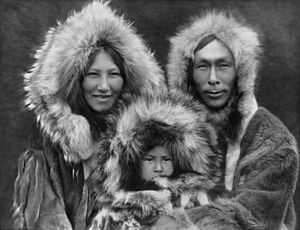
After a baby was born, one custom was for an Angakkuq (shaman) to place a tiny ivory carving of a whale into the baby's mouth. This was done in hopes that the child would be good at hunting. Loud singing and drumming were also common at birth.
Inuit families depended on others in their community to survive. Goods were shared within a household and with the whole community.
What are Inuit traditional laws and beliefs?
Inuit Qaujimajatuqangit are Inuit traditional laws. They had a set way of doing things that had to be followed. There were three main types of laws: “Maligait” (what must be followed), “Piqujait” (what must be done), and “Tirigusuusiit” (what must be avoided).

The Arctic environment inspired Inuit mythology. It was full of adventure tales about whale and walrus hunts. Long winter months, waiting for caribou or hunting seals, gave the Inuit time to tell stories. These myths were about great adventures and the mysterious appearance of ghosts and fantastic creatures.
The Inuit believed that diseases came from spiritual causes. An “angakkuq,” or shaman, was thought to have a connection with spirits in the Inuit community. They were also seen as "medicine men" who could help heal people who were sick because of spirits. Inuit religion involved many rituals.
How do Inuit govern themselves?
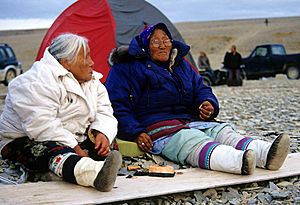
The Inuit govern themselves as much as they can. Elders are very important in their communities.
The Inuit Circumpolar Council is one of six groups of Arctic indigenous peoples. They have a special seat as a "Permanent Participant" on the Arctic Council. This council includes eight Arctic countries (USA, Canada, Russia, Denmark, Iceland, Norway, Sweden, and Finland). They meet to discuss policies for the Arctic region.
What is modern Inuit culture like?
Inuit art, such as soapstone carvings, is a very important industry in Nunavut. Carving, printmaking, textiles, performing arts, and Inuit throat singing are very popular among the Inuit community. Canada has even adopted some Inuit culture as national symbols. Storytelling, mythology, music, and dancing remain important parts of the culture. Family and community are also very important. The Inuktitut language is still spoken in many Arctic areas. It is common on radio and in television programs.
Inuit celebrate their traditional New Year, called Quviasukvik. The Arctic Winter Games are held in communities across the northern parts of the world. Traditional Inuit and northern sports are part of these events.
Today, Inuit rely more on modern society for things like jobs, food, aid, and medicine. Because of this, they interact more and more with people whose societal norms are different from Inuit culture.
Interesting facts about Inuit
- Inuit Sign Language is a dying language. Only about 50 people today are known to still speak it.
- Inuktitut is one of the most spoken languages of the Inuit people.
- A member of an Inuit community is called an “Inuk.”
- Many Inuit people believed that the spirits of their ancestors could be seen in the lights of the aurora borealis (also known as the Northern Lights).
- Kayaks, snowshoes, and snow goggles are all Inuit inventions.
- The ancient Inuit made armor from walrus teeth.
- Inuksuk are human figures built from piled stones that seem to defy gravity.
- The qamutik is a sled designed to carry heavy loads over densely packed snow and rough terrain.
- The Inuit people eat kelp, caribou liver, and seal brain raw to get all of the vitamins and minerals from them.
- Most of Greenland's population (about 89%) is Inuit.
- In the Inuit languages, the word "iglu" (plural: igluit) means any kind of house or home. It doesn't just mean a snow house! It can refer to traditional tents, sod houses, homes made of driftwood, or even modern buildings. However, outside of Inuit culture, when most people say "igloo," they are only talking about shelters made from blocks of packed snow. These are usually shaped like a dome.
Images for kids
-
Hudson's Bay Company Ships trading with Inuit off the Upper Savage Islands, Hudson Strait, 1819
See also
 In Spanish: Inuit para niños
In Spanish: Inuit para niños


